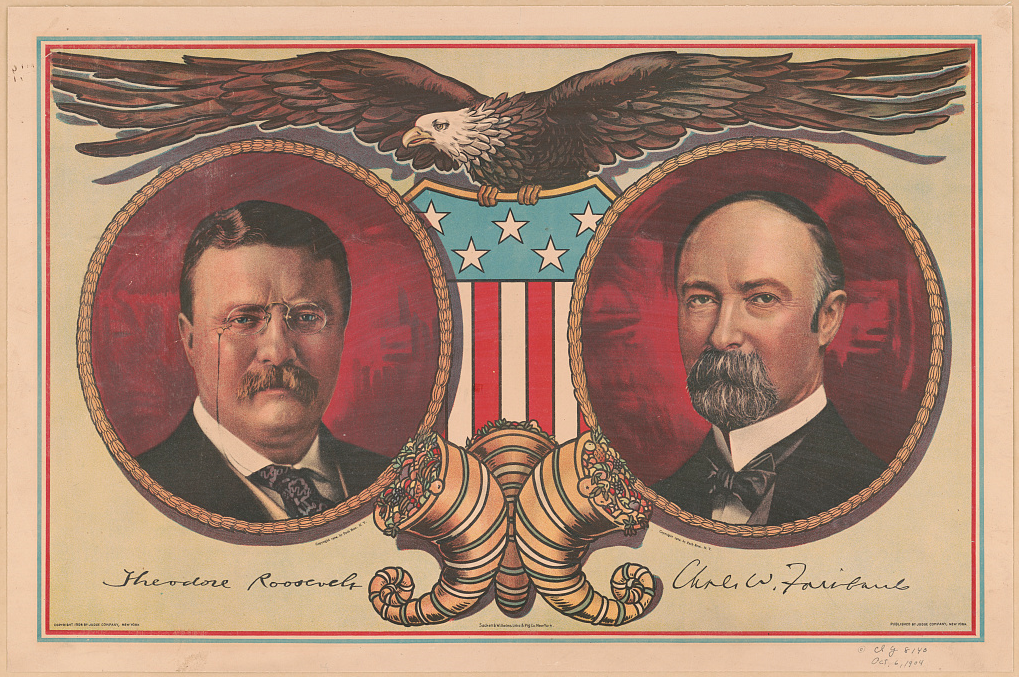Unusual Roosevelt and Fairbanks Campaign Bandanna | The Right Men in the Right Place | Circa 1904
Unusual Roosevelt and Fairbanks Campaign Bandanna | The Right Men in the Right Place | Circa 1904
Frame Size (H x L): 26” x 26.75”
Bandanna Size (H x L): 16” x 16.75”
Offered is an unusual 1904 Teddy Roosevelt and Charles Fairbanks campaign bandanna. Campaign bandannas were initially produced beginning in the first quarter of the nineteenth century, but became a particularly popular campaign tool in the time period between 1850 and 1920. They were worn, presented in store fronts, waved in parades, flown at political rallies, and hung from buggy whips.
This particular bandanna includes an image of Roosevelt with the caption, “FOR PRESIDENT | THEODORE ROOSEVELT OF NEW YORK.” It further includes an image of Fairbanks with the caption, “FOR VICE-PRESIDENT | CHARLES W. FAIRBANKS OF INDIANA.” Above Roosevelt and Fairbanks is a further caption, “THE RIGHT MEN IN THE RIGHT PLACE”—a theme for their campaign. Below them is yet a further caption, “1904 | PROTECTION | EXPANSION | PROSPERITY | SOUND MONEY”—also themes for the campaign. These themes are embedded in a ribbon, and the ribbon is attached to an oak wreath that surrounds Roosevelt and Fairbanks.
A similar bandanna is documented in the Threads of History, written by Herbert Ridgeway Collins, as item number 868. The documented example is held in an unnamed private collection. Mr. Collins was the curator of the Division of Political History at the Smithsonian Institute. The documented example, in the Threads of History, has a border of blue blocks and bars. In contrast, the example offered herein has a border of red blocks and bars. Campaign textiles often feature similar designs, but with slightly different colors, as is the case between these two examples.
The Threads of History also includes four other bandannas that use the same Roosevelt and Fairbank images, captions, ribbon, and oak wreath—but that are, in other respects, quite different. The first such example is item number 864, held in the collection of Cornell University. In this example, the bandanna does not include a border surrounding the oak wreath. The second such example is item number 865, held in the private collection of Richard Sherman. In this example, the bandanna includes a border of pink with red, white, and pink pinwheel designs. The third such example is item number 866, held in the private collection of David J. Freint. In this example, the bandanna includes a border of flags and corner motifs of three boats and a depot. The fourth such example is item number 867, held in an unnamed private collection. In this example, the bandanna includes a border with scenes of industry, an eagle, and Miss Liberty. These similar, but different, bandannas would have been made by the same person, though he or she appears to be unknown, per our research.
Theodore Roosevelt—a writer, soldier, naturalist, and statesmen—was the 26th president of the United States from 1901 until 1909. Roosevelt was elected as the governor of New York in 1898, and in this position, he was a reformer who was best known for removing corrupt officials and regulating corporations. Such actions irritated Republican leaders. And in response, they urged him to run as the vice presidential nominee with William McKinley in 1900, the thought being that Roosevelt’s vice presidential role would be ceremonial in nature and sidetrack him from continuing to reform and regulate. In 1901, however, McKinley was assassinated, and Roosevelt became the youngest president in history.
Roosevelt was known for raising awareness of the nation’s role in world politics, trust busting, regulating the railroads, and continuing to fight political corruption. Notably, in 1902, Roosevelt intervened in the anthracite coal strike upon threats to cut off heating fuel for homes, schools, and hospitals. He responded by stating that the army would run the mines, and by having Wall Street withhold credit to the coal companies and dump their stocks. His actions ended the strike and resulted in a pay increase for the miners. This was the first time that a President had publicly intervened in a labor dispute for the laborers, and he characterized his actions as working toward a “Square Deal” between capital and labor. This became Roosevelt’s slogan in his 1904 election, in which he ran against the democratic contender, Alton Parker. Roosevelt overwhelmingly defeated him by 336 electoral votes to 140. He carried every region in the Union, minus the South.
Conservation Process: This bandanna was hand sewn to cotton fabric, and both were hand sewn to a mounting board. To prevent the black dye in the cotton fabric from seeping into the bandanna, it was first washed in a standard wash and then in a dye setting wash. The bandanna is positioned behind Conservation Clear Acrylic (standard) or behind Optium Museum Acrylic (per request).
Frame: This offering is in an antique frame.
Condition Report: Nearly flawless, but with some light stains. The full extent of the stains is accurately depicted in the photographs. Overall, this is a beautiful example of this bandanna.
Collectability Level: The Great – Perfect for Rising Collectors
Date of Origin: 1904












